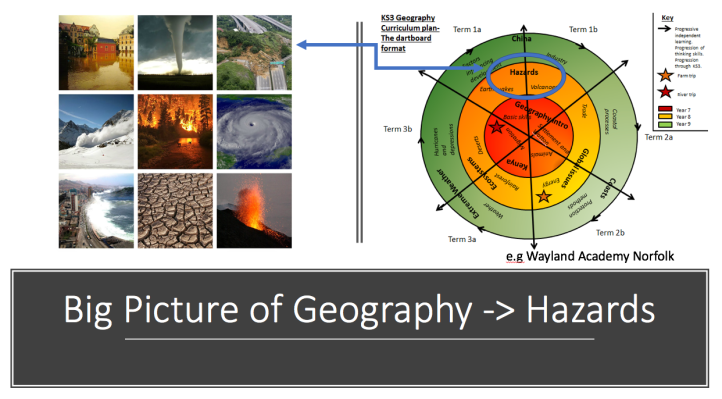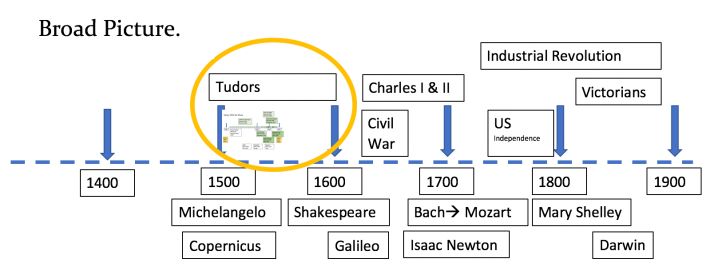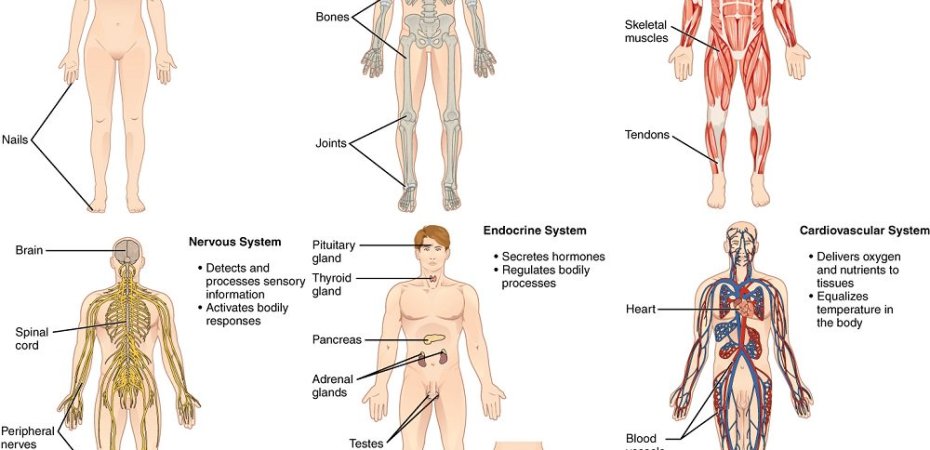#2 in a series.
I’ve often found that students in lessons are wading through a foggy cloud of confusion about why they are learning what they are learning. I’ve been in that cloud plenty of times myself. If, as an expert in a subject, you make a selection of the elements of the curriculum for your students to explore based on your expertise, there’s a risk that these elements can seem weirdly disembodied to the novices.
- Why do we need to know about aldehydes and ketones?
- Why are reading this poem by Keats? Or this book ‘Wonder’? Or Lord of the Flies?
- Why are we learning about springs and Hooke’s Law?
- Why are oxbow lakes in the geography exam?
- Why do we need to learn about King John or The Tudors?
- Why do we learn about the Great Fire of London?
- Why are we listening to 12-bar blues in music? What’s the big deal about Haydn?
- Why are we looking at paintings by Paul Klee?
- Why do we measure the surface area of triangular prisms?
And so on and on….
I’ve often felt that students would have a better sense of what was going on conceptually if they had undertaken a kind of orientation programme before diving in; an opportunity to scan the territory where the teacher mapped out what might be a sensible route through. I don’t think this happens enough.
So, for example. If we are going to study Keats, we need to know why it’s him. Who? Why? Of all the poets? Isn’t it helpful to map out the poetry landscape in advance in some broad schema of genres, periods, movements, subject matter? Of course a deeper understanding of the poetry landscape is going to emerge if you read lots of poetry- but if, in all likelihood, you’re only going to get a thin slice of it, some wider reference points would be useful.
I had a good experience of this approach studying music for O level. My knowledge of classical music is pretty thin based on my private listening preferences. But I do have a reasonably good sense of musical periods moving from madrigals to Purcell to Bach and Handel; Haydn to Mozart and Beethoven; Tchaikovsky to Mahler, Gershwin and Shostakovich; Jazz to Big Band, skiffle and the Beatles! The whole point of the course was to orientate us; sign-posting us to what might be out in wide musical world beyond.
I’ve now got a similar framework for artists and works of literature but those have only emerged over time. I remember studying the Ancient Mariner in Year 8. Why? No idea.. it was long and heavy-going and I was never sure who it was by. Then we read something by Neville Shute that seemed utterly random. We had tons of books at home but I would have killed for a more systematic literary orientation.
I love Mark Enser’s new Geography book. He makes an excellent case for consciously avoiding the trap of reinforcing narrow single-issue representations of countries: eg Bangladesh = flood risk; Brazil = favelas and Nigeria = oil-driven NEE. He suggests it might be better to focus on multiple aspects of one country so that students get a wider view of interacting issues. It’s a tricky selection to make – each issue/country case study can seem arbitrary so it’s good to have a broader framework; a rationale that teachers and students all understand.
In the last year I’ve seen a science lesson where the topic was fractional distillation of oil. The emphasis was on various concepts to do with boiling points and the labels of the apparatus but, conceptually, many students were all at sea. It seemed that the lesson was prematurely zoomed in on this technique – some laboratory apparatus. A critical missing piece was the wider context around crude oil existing as a mixture of very long chain hydrocarbons that need to be separated in order to produce products with a range of specific uses. This meant that the process of linking boiling point to ‘chain length’ felt extremely obscure.
Perhaps even more importantly students were not clear that ‘hydrocarbons’ are likely to contain largely hydrogen and carbon and did not have the super-important bit of context which is that they would have originated from the remains of carbon-storing plants and animals that died millions of years ago – hence the issue of returning carbon dioxide to the atmosphere, leading to climate change and so on. Arguably all that would come later but a lesson about fractional distillation seems pretty random without some sense of direction in a wider map of the curriculum territory.
I have searched high and low for examples of good visual examples. Here are some about literary genres.

Here are some I found linking eg earthquakes within a wider topic on hazards in turn linked to a wider view of Geography:

The best served area is History because timelines provide a well-used way of organising ideas. Here is one I made when looking into my knowledge of Henry VIII’s wives:

The featured image for this post comes from science: Organ systems in the human body: It helps to know the wide frame of systems before looking at each one and then zooming into cellular activity in muscles of alveoli or reproductive organs.

I could have chosen numerous other examples including the periodic table, the ‘tree of life’ evolution story or any number of classification diagrams. Science is big into classification!
The general point is to make sure your students are well-orientated in a wider picture before getting stuck into the detail. To reference my New York Map analogy, the sights and sounds of E21st Street or the West Village make a lot more sense if you know where you are in relation to New York as a whole.

Any big picture(s) on Physics. I appreciate Ben Rogers book but it is aimed at secondary. Is there a Science (not bio) pic for Primary …
LikeLike
[…] Curriculum notes #2: Big picture first then zoom in […]
LikeLike
Really interesting post, Tom. I work with teaching and learning across a Trust, and I’m trying to get the learning leads to think about this as a way of building a sound curriculum base. The notion of threshold concepts, combined with ‘big ideas’ is one that we’re exploring. I love the idea of having a year 7 art curriculum, for instance, based aroung a big idea such as ‘why do we value some artists over others?’. Imagine the cultural capital, knowledge and skills that we could build into such a model? I observed a geography lesson this week which reduced the concept of colonialism to a sentence. When challenged, the teacher said that ‘we don’t need to do any more than that’ … Knowledge reduced to a bite-size chunk, and the scourge of a 1000 years reduced to a moment in a lesson …
LikeLiked by 1 person
[…] Curriculum Notes #2: Big picture first: then zoom in. […]
LikeLike
[…] Tom Sherrington has also written about it in his blog post Curriculum Notes #2: Big picture first: then zoom in. […]
LikeLike